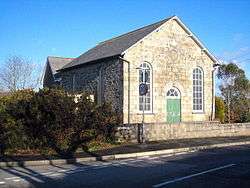St Mewan
St Mewan (Cornish: Sen Mewen) is a civil parish and village in south Cornwall, England, United Kingdom.
St Mewan
| |
|---|---|
 St Mewan Location within Cornwall | |
| Population | 3,210 (United Kingdom Census 2011 including Hewas Water ) |
| OS grid reference | SW998517 |
| Civil parish |
|
| Unitary authority | |
| Ceremonial county | |
| Region | |
| Country | England |
| Sovereign state | United Kingdom |
| Post town | ST. AUSTELL |
| Postcode district | PL26 |
| Dialling code | 01726 |
| Police | Devon and Cornwall |
| Fire | Cornwall |
| Ambulance | South Western |
| UK Parliament | |

The village is approximately one mile (1.6 km) west of St Austell.[1] It is a small settlement, comprising the parish church, rectory, a school and nearby farms. St Mewan parish includes the villages of Sticker, Trelowth, Trewoon, and most of Polgooth.[2] An electoral ward with the name St Mewan also exists. The population at the 2011 census was 3,402.[3]
Parish church
The church is dedicated to Saint Mewan, a sixth-century Celtic saint who was born in Wales, visited Cornwall, and is mostly venerated in Brittany. The current building dates from the 13th century and is mentioned in a bishops' inquisition of 1294 as the 'Ecclesia de St Mewany'.[4] It was, however, substantially rebuilt in 1854 by George Edmund Street[5] and enlarged in 1890.[6] The church tower is of only two stages and is built of granite blocks. Local legend suggests that the original builders were prevented from raising it higher by the devil, who threw down their stones each night.[7]
Education
St Mewan Community Primary School[8] was founded (as St Mewan Board School) in the nineteenth century, the main building being designed by Silvanus Trevail in 1874. The schoolmaster's house had previously been the St Mewan Inn.[9] The school currently has around 400 pupils.[10]
St Mewan Beacon
This natural landmark lies some distance from the village, to the north-west of Trewoon. It is a tor exposure of quartz-topaz-tourmaline rocks that has been designated a Site of Special Scientific Interest (SSSI) for its geological characteristics.[11] St Mewan Beacon was studied by Cornish mining engineer and mineralogist Joseph Henry Collins who published an account of it in 1914.[12][13]
References
- Ordnance Survey: Landranger map sheet 200 Newquay & Bodmin ISBN 978-0-319-22938-5
- https://web.archive.org/web/20090207062603/http://stmewanparishcouncil.co.uk/idbuilder.nsf/ids/0004C2DA. Archived from the original on 7 February 2009. Retrieved 19 May 2007. Missing or empty
|title=(help) - "Ward population 2011". Retrieved 14 February 2015.
- "Parish of St Mewan". Homepages.rootsweb.ancestry.com. Retrieved 13 October 2014.
- N. Pevsner, Cornwall, 2nd ed. p.191. Penguin Books (1970)
- Archived July 16, 2011, at the Wayback Machine
- W. Penaluna, An Historical survey of the County of Cornwall vol.2, p.93 (1838)
- "St Mewan Community Primary School". St-mewan.cornwall.sch.uk. Retrieved 13 October 2014.
- "Schools designed by Silvanus Trevail". Luxsoft.demon.co.uk. Retrieved 13 October 2014.
- "St Mewan Beacon" (PDF). Natural England. 1993. Retrieved 11 November 2011.
- J. H. Collins & F. Coon, "On the topaz rock of St Mewan Beacon, Cornwall", Transactions of the Royal Geological Society of Cornwall; Vol. XV, 43-54 (1914)
- Archived July 24, 2008, at the Wayback Machine
External links
| Wikimedia Commons has media related to St Mewan. |